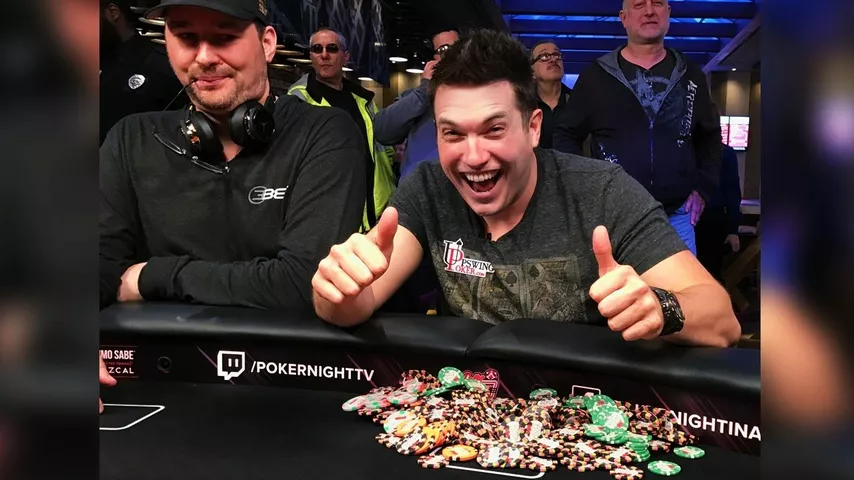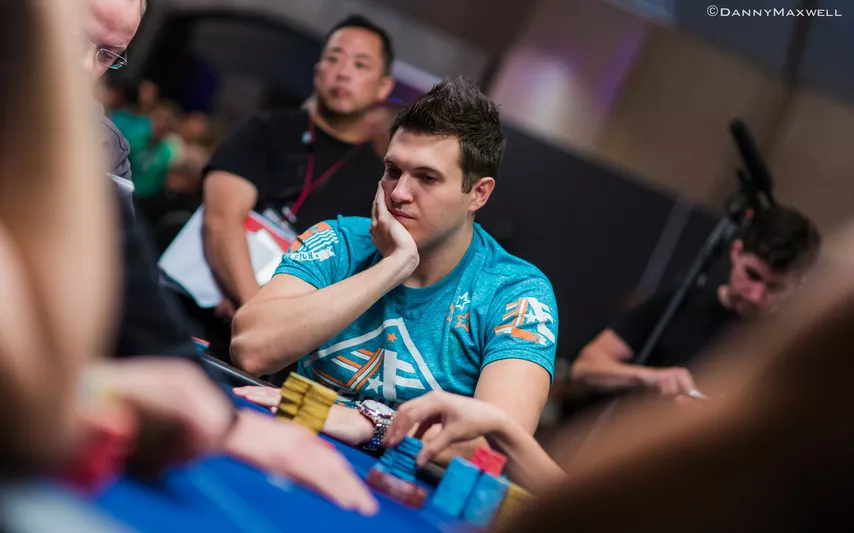(Read part 1 of the interview here)
Mike Brady: Let's move on to post-flop. In one episode of the podcast, of course, we will not be able to cover all the topics related to post-flop in heads-up play, so I will not even ask specific questions. Let's do it differently. Before recording the podcast, I asked you to come up with your top three tips for playing heads-up after the flop. What would be your first piece of advice?
Doug Polk: We only need multiple sizes on the river. I advise you to build a strategy for the flop and turn with only one size. When it comes to your turn, think about what sizing you want to play with on that texture. Does it fit your hand? If not, just check. In my opinion, people like to complicate things too much, including when they shouldn’t. Most top one-on-one players play exactly like I said. Trust their understanding: they know what they are doing.
We will only need several sizes on the river. Only there we need two ranges – for a small bet and a large one. And even then not on all textures; in many cases, you can get by just fine with one. But when we're out of position, it's often a good idea to have a block bet of a quarter or a third of the pot and a large sizing of two-thirds to the full pot. We will also have two sizes in the position, only larger: say, 2/3 of the pot and 150% or even all-in. I'm sure you've come across hands where you need to overbet your entire stack on the river. This technique is usually quite fun to use.
However, I advise you to play simpler until the river. We think about the best sizing and either apply it or check.
MB: I want to emphasize once again that Doug is not talking about the best sizing for a particular hand, but the optimal one for your entire range on a particular texture. Let's say on the flop solvers prefer to use very small bets for continuation bets, approximately 20%. Stick to this recommendation and either bet 20% or check, but don't bet 20% with top pair and 67% with flushes.
DP: One more note. When you're playing cash games against multiple opponents, especially when lineups change regularly, masking your range is usually not necessary. Even if the opponent, after the showdown, understands exactly what you are doing, a situation where you can be caught doing this will almost certainly never arise again.
However, in heads-up, you play many hands against the same opponent, and situations repeat themselves much more often. Your strategy will still deviate from the optimal one, this is inevitable because we are all human. And so in many lines, the best advice is not to chase the tiny extra expectation from a complex betting system. If you mess up even a little and your opponent figures it out, he will start to exploit your sizings and you will lose a lot more. So don’t invent anything and calmly play the flop and turn with the same size.
MB: That's right. Let's move on. Your second piece of advice?
DP: Some may be surprised, but in heads-up, we regularly have to bluff and even barrel with absolutely no equity. In other full-table formats, everyone's ranges are tight, so bluffs need outs. Even a small pocket pair that you turn into a bluff on the turn can catch a set on the river. In HU NL, from time to time we bluff with complete garbage and go all the way!

Let's say we called a 3-bet with A2s 100 blinds deep. On many boards, we will have to bet the flop, turn, and river, even if we are not hooked on the board at all. Why? Exclusively because we unlock a lot of hands – all sorts of middle pocket pairs, second pairs, and other combinations that pay the flop and turn and fold the river.
In some cases, the solver will use a pair of twos for this purpose. Another common hand for these bluffs is the worst possible suited connector. For example, 43s. We called the 3-bet and saw the flop . If the opponent checks, the solver offers us to bet three barrels. What would you think of a man who played like that on a 6-max table and showed his cards? That he is an idiot who gives money. But in heads-up, this is a standard and fairly reasonable option for playing a certain part of the range.
Yes, of course, we will also have semi-bluffs with straight draws, flush draws, etc. that you can barrel with. Unfortunately, their common problem is that if they miss the draw, they block their opponents from folding on the river. That's why we rarely bluff with high flush draws: we would like to see such hands from our opponents. And therefore, players in position should often bluff without equity, but with good anti-blockers.
Without position, this also happens from time to time, but much less often. The reason is simple: our out-of-position bluffs require more equity. Out of position, we tend to play less aggressively and use smaller sizes, so our draws need to be subtle and our bluffs need to have equity.
MB: Simply great! It turns out that you need to constantly look for situations for bluffs without equity, paying attention to the effect of blockers.
DP: There's something else just for you, Brady. I noticed an interesting thing in once-raised pots when there is a flush draw on the turn. In position, we bluff the turn with one card of the suit, without direct equity, taking advantage of the fact that our suit card blocks some of our opponent’s calls with a flush draw. In such a situation, the solver quite often prefers to barrel when our suit card is small and checks with a large one. I don't know why, but robots definitely like it.
MB: Yeah, and I also noticed that when the flush closes, the solver likes to bluff, because he has a flush blocker! That's the mechanics.
DP: Well, sometimes you also have to bluff, because one blocker for a flush draw is still better than two. And when our suit card is small, we block fewer strong flush draws that our opponent calls the turn and fold river. This may be one of the reasons why the solver chooses these hands to bluff on the turn.
We started to get pretty deep into the woods. I just wanted to give a specific example of bluffing without equity, taking into account the texture features.
MB: Yes, great. I think many of our listeners enjoyed this retreat specifically for poker nerds. Continue. What would be your third piece of advice?
DP: It's useful in all types of poker. Who doesn't love betting extra on the river? You're sitting there with clearly the best hand, happy with yourself, dreaming about Vegas and the damn Mirage ... Instead, ask yourself: what are you going to bluff with in this situation? And do this every time, literally every time you place a value bet, from this minute until the end of your days. This will create a habit that will make you a stronger player because it will reshape your thinking, give your game balance, and teach you to respect proper range formation.

MB: I think that's really important. We all know how to choose good additional hands, even beginners; this is done intuitively. Sensitivity does not work with bluffs; an analysis of the pros and cons of a hand on a specific texture is required. This requires practice. If you take the path of least resistance, you can easily turn into a player who almost never bluffs simply because he doesn't want to strain his brain. So exercise your bluffing muscle!
DP: Bluff muscle, I love it. Yes, it needs to be developed. Have a bicep day, a leg day, and a bluff day. Great.
People are naturally risk averse. We like to take small risks for big gains. That's why tournaments are so popular, but the same story happens, for example, in investing or betting. People just love the idea of making a small bet and winning a big pot. And no one likes to take big risks for little gain. This is contrary to human nature.
For example, there's $80 in the pot and the solver says, well, I'm all-in for $3,000. "What? If you have your own money, then you’re welcome, but I’ll play with mine and I’ll do without such moves,” the man will answer him.
Instead of delving into the calculations and analyzing whether this is the most profitable action, a person follows his emotions and refuses to go all-in simply because he does not want to risk his entire stack for a small part of it. In my opinion, the transition from emotional decisions to informed ones is the most important step that needs to be taken for poker to turn from a hobby into a profession. Make the right decisions, mathematically based, not build a strategy on emotions – this is exactly what I teach in The End Boss System course.
If you want to play poker at a high level, you will have to get used to being constantly presented with very difficult choices. If you're hoping to make money against strong opponents by playing only in your comfort zone, you're doomed. Learn to make difficult decisions and it will be easier for you in any lineup.
MB: Where can you get confidence in the correctness of difficult decisions?
DP: We agreed on three tips, but I'll give the fourth for the price of three.
Popular wisdom in poker says that if you don't know what to do, fold: folding has zero expectation and is better than making an expensive mistake.
I look at it completely differently.
In my opinion, if you are hesitating, if you want to make a move, but you are not quite sure about it, step on the gas! Yes, this can be a costly mistake. We are not perfect, we do not have all the answers. However, all my experience playing and working with other regulars over the years suggests that people suffer much more not from bold decisions, but from conservative ones.
They don't bite into cans! They don’t cling to their own and don’t try to scratch out someone else’s! All they need is to minimize losses.
I think you've all often seen how good players push their opponents stack after stack, and you think: okay, this is a terrible game, what nonsense? And then you check it in the solver, and it turns out that it was brilliant. Have they really found the perfect balance between burning and printing money? Who knows? But they are definitely not afraid to take risks.
So the next time you think about bluffing the river and start weighing the pros and cons, just relax and do it for Doug's sake. Just don't send me the bill later.


















